7 Wonders
Game preparation
With /join can enter 3-5 players into the game. With /start the game begins. Alternatively, you can use the game management use.
The game
Each player tries to collect raw materials and manufactory products over three periods of time to create different buildings and a world miracle. What you do not have can be purchased from the neighbors. But the neighbors are not always peaceful, so you should not neglect his army.
This guide mainly explains the online service. The complete rules as pdf exist here.
Field
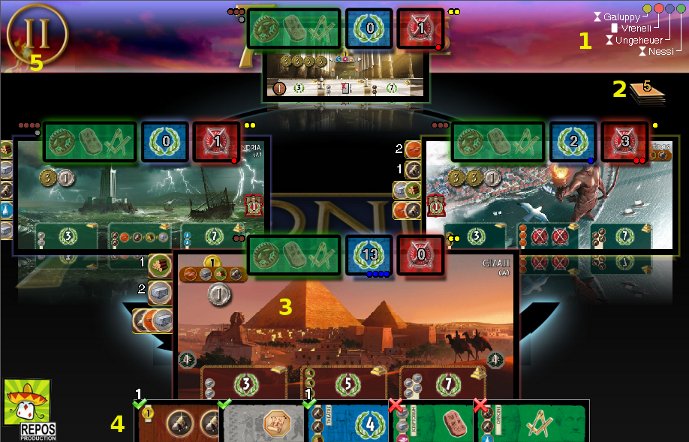
- Player display
- Stacks
- Player tableau
- Handcards
- Age
Player tableau
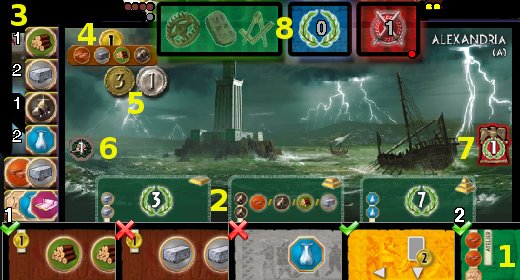
- Handcards
- Building stages of the world miracle
- Own raw materials and manufacturing products
- Display Accounts
- Own coin supply
- Default marker
- Victory marker
- Issued cards: raw material and manufactory cards are displayed on the left as brown or gray points, trading buildings (yellow) and guilds (lila) cards on the right. Research buildings (green), professional buildings (blue) and military cats (red) can be seen in the middle. To view the maps more accurately, you simply drive with the mouse over the corresponding color points.

At the top right, all players will be displayed. If you click on a color point, the corresponding player tray will be pushed forward. Once you click the same color point again, the background is darkened and the maps are hidden.
If you travel with the mouse over opposing tableaus, the name of the owner is colored in its color. The symbols before the name indicate who has already selected a card in the current round: So the players with a sand watch have already chosen, the players with the card symbol still have to choose.
Game sequence
Each player receives at the beginning one of the world miracles at the same time. In addition, each player gets three coins as start capital.
Played over three ages, each age consists of six rounds. Each round runs as follows:
- Select a map
- Use map
- Share remaining cards
Select maps
At the beginning of the age, each player has seven cards on hand. He can choose one of them. He passes the remaining cards so that you get the cards of the neighbor in each subsequent round, one less than in the round before.
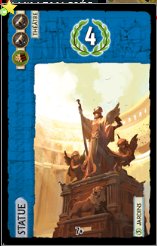
Meaning of card symbols:
- The construction costs are displayed on the top left. These can be raw materials as here, but also goods or coins are possible.
- Above in the middle the effect of the card is displayed (see Card Overview), here for example four points of victory
- At the bottom of the left is the name of the building (Statue)
- At the top left, right from the construction costs, is the name of the building, because of which this building can be bought for free (Theater)
- At the bottom right is the name of the building that I can build for free in the future (gardens). An overview of the relationships of the buildings is available on page 10 and 11 of the Original Rule.
There are seven different types of cards:
- Raw material maps (brown): They produce the raw materials (wood, stone, brick, ore)
- Manufactory products (grey): They produce the manufacture products (substance, glass, papyrus). Furthermore, they are briefly referred to as goods.
- Commercial building (yellow): Take e.g. advantages when acting with neighbors
- Profanbauten (blue): Bring victory points immediately
- Military cards (red): Determine the military strength for the struggle at the end of every age
- Research building (green): The research buildings at the end of the game bring victory points for the collected symbols (see final score)
- Guilds (lila): Guilds end up winning points for certain cards of the opponent (see final score)
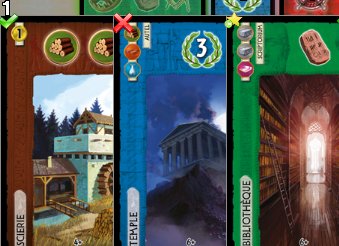
The hand maps show whether you can buy the card (green hook), can not buy (red cross) or can build for free (yellow star).
There are maps that don't cost anything (e.g. some raw material maps in the first age), with all other maps the construction costs are displayed on the top left. This can be in the form of coins (e.g. the brown card in the image) or raw materials. In the case of purchaseable cards, the minimum costs are given above the green hook (here 1 at the wooden card).
To select a card, click it with the mouse.
Use map
With each card you can use one of three options:
- Building buildings
- Building stage of your own world miracle
- Take three coins from stock
Building buildings
This is the most used action. You pay the construction costs and get the building into its deposit. You can use your skills from now on.
If you select the card with one click, you will get the following selection:
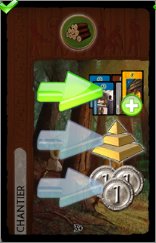
With the top symbol you can now choose to build the building. Click on the top (green) arrow. If you have to pay raw materials or goods to build this building, the payment window opens:
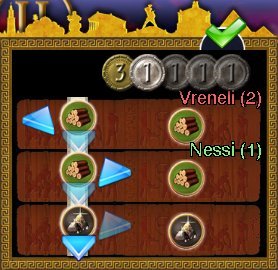
On the left are the required raw materials/goods, above the own coin supply. If you produce the raw materials you need, you select the blue arrow down (here the ore). If a commodity/good is missing, you can buy it from the direct neighbors. This costs two coins each. For this purpose, the corresponding blue arrow is selected to the left or right. The number of coins used in this case is displayed darkened (here 2 + 1 = 3 coins). You complete the construction by clicking on the green hook.
For action:
- Only raw materials/goods can be bought from the direct neighbors right and left of the player
- The neighbor cannot prevent the purchase, but naturally gets the coins. He himself can still use the raw material/goods in his own train.
- For sale only the raw materials/goods produced by the neighbour by means of brown/grey goods (i.e., for example, not the raw materials/goods from Forum/Karawanserei) and the raw material (worldly wonder-dependent)
- You can only buy raw materials/goods for the current round
- It is also possible to buy several raw materials/goods from the same or from different neighbors as long as they produce many accordingly.
- If a player has an account or market, he can buy raw materials/goods for only one coin from the corresponding neighbor
Note: Raw materials/goods are only "virtual", i.e. they will not be used as raw material cards or blocks, as they would suspect. They are not released after use but remain with the player and can be reused in each round. However, each raw material/good can only be used once per round.
A player may have the same building not Build twice!
Building stage of your own world miracle
Each world miracle has two sides: an A-side and a B-side. Which one is played is determined before the start of the game. The A-sides each have three construction stages, with the B-sides the number of construction stages varies. On the A-pages, building the first stage always brings three win points, building the third stage always seven points. The second stage brings a world-famous special bonus (see map).
You always start with the left level and work to the right. In order to build a stage, the corresponding imprinted raw materials and Other Handcard. This one comes undercover from the game.
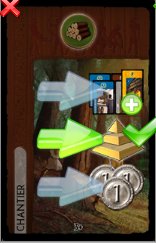
To build a world miracle, you simply select the second arrow on the map.
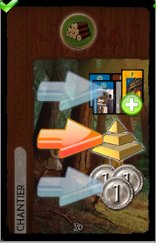
If the arrow is orange, the world miracle cannot be built because, for example, the necessary raw materials are not present.
Note:World miracles don't necessarily have to be built to play (ready). You can also finish the game without building a single stage. The construction of the stages is also not dependent on the age. Thus, for example, in the first age one cannot build anything, then in the second stage 1 and 2.
Take coins
This action can always be chosen. Man can also use cards carrying the red X. The map you choose for this is, as in the case of world miracles, absolutely irrelevant. After the action, it is placed undercover on the storage stack.
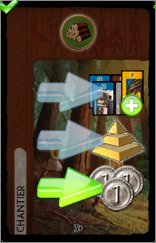
To get three coins for one card, choose the lowest card action.
Postcards
If each player has chosen and used a card, the remaining cards will be passed down to the neighbor. In the first and third ages this happens clockwise, in the second age counterclockwise.
In the sixth round each player has two cards to choose from. As usual, he chooses one of them, the last card of each player then moves to the storage stack.
End of an Age
At the end of each age, the military conflict is held. For this, each player compares the number of his shields (red cards) (separated) with each of his two neighbors.
- If he has more shields, he gets a victory marker. Victory marker of 1./2./3. Ages are worth 1/3/5 win points
- If he has less shields, he gets a defeat marker (-1 victory point)
- If he has many shields, nothing happens
Playing
The game ends after the military conflict of the third age. All winning points are added (S. final score). The player with most winning points wins the game. At the same time, the number of coins decides. There are several winners.
Final value
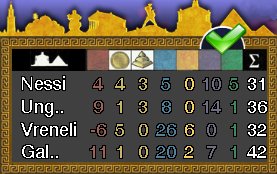
From left to right:
- Name
- Combat points: The addition of (positive and negative) conflict markers
- Coins: Three coins each make a victory point
- World miracle: Victory points through the construction of world miracles (see World Wonder Table)
- Profanbauten: Siegpunkt durch die Profanbauten (blue)
- Commercial building: Some commercial buildings end up with points of victory (see Map Overview)
- Guilds: The guilds bring victory points similar to the commercial buildings at the end (see Card Overview)
- Research building: The research buildings bring points as follows:
*1/4/9/16 victory points for 1/2/3/4 the Symbols
*7 points of victory for each set
The winning points from both categories are added
Since it can also form two complete sets, it receives 2 x 7 = 14 points. It thus receives 17 + 14 = 31 points for its research building.
Options
side A
It is only played on the A-pages of the World Wonder Table. Recommended for the first rounds.
side B
It is only played on the B-pages of the World Wonder Table.
side A+B
Both sides of the world miracle tablet can be constrained.

